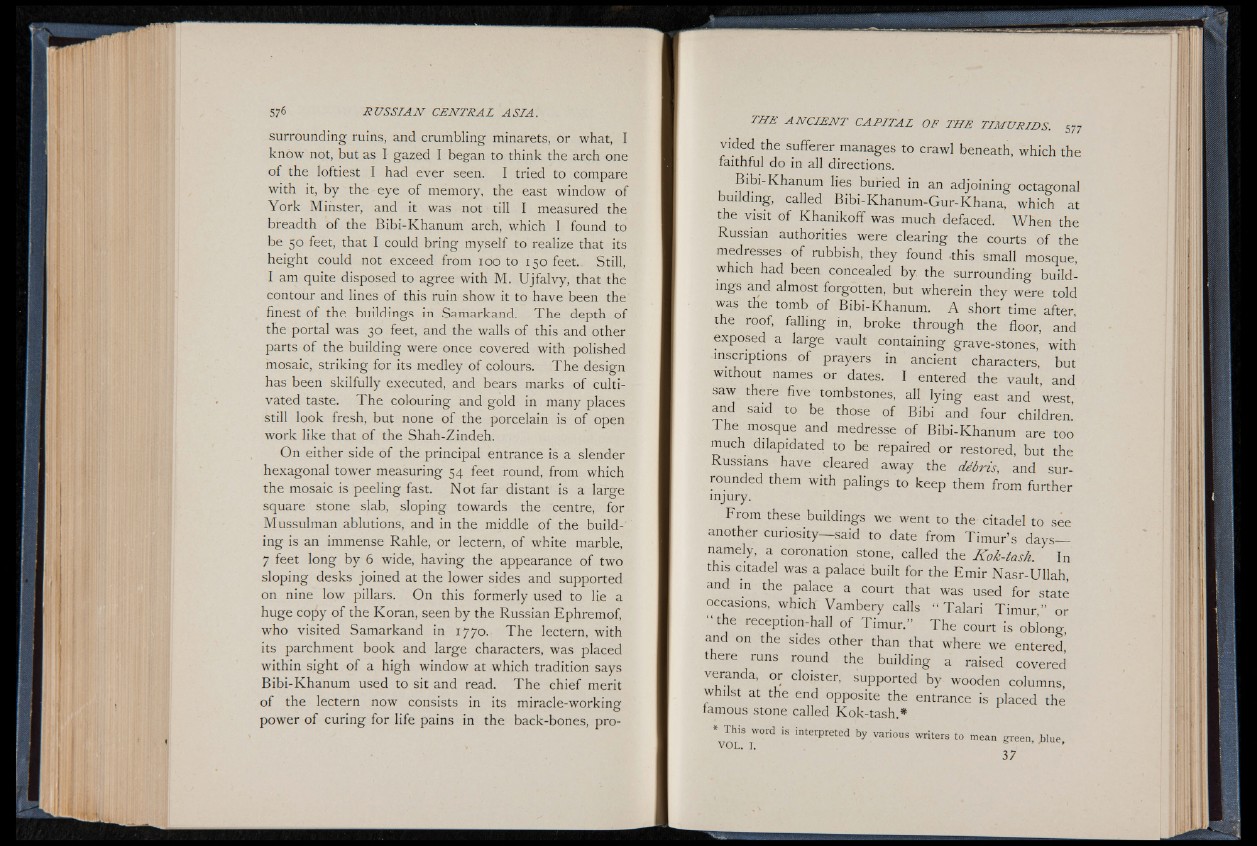
surrounding ruins, and crumbling minarets, or what, I
know not, but as I gazed I began to think the arch one
of the loftiest I had ever seen. I tried to compare
with it, by the eye of memory, the east window of
York Minster, and it was not till I measured the
breadth of the Bibi-Khanum arch, which I found to
be 50 feet, that I could bring myself to realize that its
height could not exceed from 100 to 150 feet. Still,
I am quite disposed to agree with M. Ujfalvy, that the
contour and lines of this ruin show it to have been the
finest of the buildings in Samarkand. The depth of
the portal was 30 feet, and the walls of this and other
parts of the building were once covered with polished
mosaic, striking for its medley of colours. The design
has been skilfully executed, and bears marks of cultivated
taste. The colouring and gold in many places
still look fresh, but none of the porcelain is of open
work like that of the Shah-Zindeh.
On either side of the principal entrance is a slender
hexagonal tower measuring 54 feet round, from which
the mosaic is peeling fast. Not far distant is a large
square stone slab, sloping towards the centre, for
Mussulman ablutions, and in the middle of the build-'
ing is an immense Rahle, or lectern, of white marble,
7 feet long by 6 wide, having the appearance of two
sloping desks joined at the lower sides and supported
on nine low pillars. On this formerly used to lie a
huge copy of the Koran, seen by the Russian Ephremof,
who visited Samarkand in 1770. The lectern, with
its parchment book and large characters, was placed
within sight of a high window at which tradition says
Bibi-Khanum used to sit and read. The chief merit
of the lectern now consists in its miracle-working
power of curing for life pains in the back-bones, provided
the sufferer manages to crawl beneath, which the
faithful do in all directions.
Bibi-Khanum lies buried in an adjoining octagonal
building, called Bibi-Khanum-Gur-Khana, which at
the visit of Khanikoff was much defaced. When the
Russian authorities were clearing the courts of the
medresses of rubbish, they found -this small mosque,
which had been concealed by the surrounding buildings
and almost forgotten, but wherein they were told
was the tomb of Bibi-Khanum. A short time after,
the roof, falling in, broke through the floor, and
exposed a large vault containing grave-stones, with
inscriptions, of prayers in ancient characters, but
without names or dates. I entered the vault, and
saw there five tombstones, all lying east and west,
and said to be those of Bibi and four children.’
The mosque and medresse of Bibi-Khanum are too
much dilapidated to be repaired or restored, but the
Russians have cleared away the cUbris, and surrounded
them with palings to keep them from further
injury.
From these buildings we went to the citadel to see
another curiosity— said to date from Timur’ s days—
namely, a coronation stone, called the Kok-tash. In
this citadel was a palace built for the Emir Nasr-Ullah,
and in the palace a court that was used for state
occasions, which Vambery calls “ Talari T im u r ” or
“ the reception-hall of Timur.” The court is obiong,
and on the sides other than that where we entered,’
there runs round the building a raised covered
veranda, or cloister, supported by wooden columns,
whilst at the end opposite the entrance is placed the
famous stone called Kok-tash.*
♦yThis word is interpreted by various writers to mean green, Jjlue,
L‘ L 37